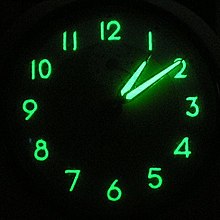Radium dials

A 1950s radium clock, exposed to ultraviolet light to increase luminescence
Radium dials are watch, clock and other instrument dials painted with radioluminescent paint containing radium-226. Radium dial production peaked in the first decade of the 20th century as radiation poisoning was then unknown; subsequently, radium dials have largely been replaced by phosphorescent- or occasionally tritium-based light sources.
Contents
1 Brands
2 History
3 Safety
4 See also
5 Sources
6 References
Brands
Undark produced by the United States Radium Corporation
Luna produced by the Radium Dial Company
Marvelite produced by the Cold Light Manufacturing Company (a subsidiary of the Radium Company of Colorado)
History
Radium was discovered in the early 1900's and was soon combined with paint to make luminescent paint, which was applied to clocks, airplane instruments, and the like, to be able to read them in the dark. [1]
Radium dials were typically painted by young women, who used to 'point' their brushes by licking and shaping the bristles prior to painting the fine lines and numbers on the dials. This practice resulted in the ingestion of radium, which caused serious jaw-bone degeneration and malignancy and other dental diseases reminiscent of phossy jaw. The disease, radium-induced osteonecrosis, was recognized as an occupational disease in 1925 after a group of radium painters, known as the Radium Girls, from the United States Radium Corporation sued. By 1930, all dial painters stopped pointing their brushes by mouth. Stopping this practice drastically reduced the amount of radium ingested and therefore, the incidence of malignancy, to zero by 1950 among the workers who were studied.
"Luminous Processes employees interviewed by a journalist in 1978 had been left ignorant of radium's dangers. They were told that eliminating lippointing had ended earlier problems. They worked in unvented rooms, they wore smocks that they laundered at home. Geiger counters could pick up readings from pants returned from a dry cleaner and from clothes stored away in a cedar chest."[2]
Safety
Although old radium dials may no longer produce light, this is frequently due to the breakdown of the crystal structure of zinc sulfide rather than the radioactive decay of the radium, which has a half-life of about 1600 years,[3] so even very old radium dials remain radioactive. Radium paint can be ingested by inhaling flaking paint particles. The alpha particles emitted by the radium, which is taken up in bone, will kill off surrounding bone tissue, resulting in a condition loosely referred to as radium jaw. Inhaled or ingested particles may deposit a high local dose with a risk of lung or gastrointestinal cancer due to the radiation dose. The risks are hard to quantify due to the variable levels of radium in the paint and the quantity ingested or inhaled. Care should be taken in handling these materials especially where the paint is damaged.
The most common isotope of Radium is 226Ra, which primarily emits alpha particles.[3] Alpha particles are shielded by most thin materials including paper. However, 226Ra only emits alpha particles 97 percent of the time with 186 keV gamma emission 3% of the time. Also, 226Ra is rarely present without other transuranic elements or decay products, which may emit beta or gamma radiation. Therefore, the radiation hazards from radium paint may not be entirely removed by the varnish, case or container. Care should be taken to prevent the inhalation or ingestion of flakes or dust which may contain radioactive materials. Radium dials have been shown to have dose rates near the face of in excess of 10uSv / hr, which would deliver a dose equivalent to one days background exposure in around 20 minutes. This dose rate probably only represents the gamma emission as the alpha emission will be stopped by the lacquer or case. Hence the dose rate following ingestion or inhalation of the dust could be much higher.
See also
- Radioluminescence
- Radioactive phosphors
- Luminous paint
- Radium girls
Sources
- Radium Girls: Women and Industrial health reform, 1910–1935, .mw-parser-output cite.citation{font-style:inherit}.mw-parser-output .citation q{quotes:"""""""'""'"}.mw-parser-output .citation .cs1-lock-free a{background:url("//upload.wikimedia.org/wikipedia/commons/thumb/6/65/Lock-green.svg/9px-Lock-green.svg.png")no-repeat;background-position:right .1em center}.mw-parser-output .citation .cs1-lock-limited a,.mw-parser-output .citation .cs1-lock-registration a{background:url("//upload.wikimedia.org/wikipedia/commons/thumb/d/d6/Lock-gray-alt-2.svg/9px-Lock-gray-alt-2.svg.png")no-repeat;background-position:right .1em center}.mw-parser-output .citation .cs1-lock-subscription a{background:url("//upload.wikimedia.org/wikipedia/commons/thumb/a/aa/Lock-red-alt-2.svg/9px-Lock-red-alt-2.svg.png")no-repeat;background-position:right .1em center}.mw-parser-output .cs1-subscription,.mw-parser-output .cs1-registration{color:#555}.mw-parser-output .cs1-subscription span,.mw-parser-output .cs1-registration span{border-bottom:1px dotted;cursor:help}.mw-parser-output .cs1-ws-icon a{background:url("//upload.wikimedia.org/wikipedia/commons/thumb/4/4c/Wikisource-logo.svg/12px-Wikisource-logo.svg.png")no-repeat;background-position:right .1em center}.mw-parser-output code.cs1-code{color:inherit;background:inherit;border:inherit;padding:inherit}.mw-parser-output .cs1-hidden-error{display:none;font-size:100%}.mw-parser-output .cs1-visible-error{font-size:100%}.mw-parser-output .cs1-maint{display:none;color:#33aa33;margin-left:0.3em}.mw-parser-output .cs1-subscription,.mw-parser-output .cs1-registration,.mw-parser-output .cs1-format{font-size:95%}.mw-parser-output .cs1-kern-left,.mw-parser-output .cs1-kern-wl-left{padding-left:0.2em}.mw-parser-output .cs1-kern-right,.mw-parser-output .cs1-kern-wl-right{padding-right:0.2em}
ISBN 978-0-8078-4640-7
References
^ https://www3.epa.gov/radtown/antiques.html
^ Clark, Claudia. The Radium Girls (
ISBN 978-0-8078-4640-7)
^ ab "Radium". EPA. Retrieved 10 January 2011.
